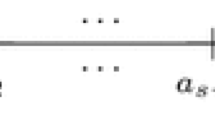Abstract
A scoring method based on paired comparison allowing multiple choice is investigated. We allow general log-concave probability density functions for the random variables describing the difference of the objects. This case involves Bradley–Terry models and Thurstone models as well. A sufficient condition is proved for the existence and uniqueness of the maximum likelihood estimation of the parameters in case of incomplete comparisons. The axiomatic properties of the method are also investigated.
Similar content being viewed by others
References
Agresti A (1992) Analysis of ordinal paired comparison data. Appl Stat 41(2):287–297
Bradley RA, Terry ME (1952) Rank analysis of incomplete block designs: I. The method of paired comparisons. Biometrika 39(3/4):324–345
Bozóki S, Fülöp J, Rónyai L (2010) On optimal completion of incomplete pairwise comparison matrices. Math Comput Modell 52(1):318–333
Cattelan M (2012) Models for paired comparison data: a review with emphasis on dependent data. Stat Sci 27(3):412–433
Chebotarev PY, Shamis E (1998) Characterizations of scoring methodsfor preference aggregation. Ann Oper Res 80:299–332
Davidson RR (1970) On extending the Bradley–Terry model to accommodate ties in paired comparison experiments. J Am Stat Assoc 65(329):317–328
Ford LR (1957) Solution of a ranking problem from binary comparisons. Am Math Mon 64(8):28–33
González-Díaz J, Hendrickx R (2014) Paired comparisons analysis: an axiomatic approach to ranking methods. Soc Choice Welf 42(1):139–169
Mosteller F (1951) Remarks on the method of paired comparisons: I. The least squares solution assuming equal standard deviations and equal correlations. Psychometrika 16(1):3–9
Orbán-Mihálykó É, Mihálykó Cs, Koltay L (2017) A generalization of the Thurstone method for multiple choice and incomplete paired comparisons. Cent Eur J Oper Res. https://doi.org/10.1007/s10100-017-0495-6
Prékopa A (1973) Logarithmic concave measures and functions. Acta Sci Math 34(1):334–343
Rubinstein A (1980) Ranking the participants in a tournament. SIAM J Appl Math 38(1):108–111
Rao PV, Kupper LL (1967) Ties in paired-comparison experiments: a generalization of the Bradley–Terry model. J Am Stat Assoc 62(317):194–204
Saaty TL (1990) How to make a decision: the analytic hierarchy process. Eur J Oper Res 48(1):9–26
Stern H (1990) A continuum of paired comparisons models. Biometrika 77(2):265–273
Stern H (1992) Are all linear paired comparison models empirically equivalent? Math Soc Sci 23(1):103–117
Thurstone LL (1927) A law of comparative judgement. Psychol Rev 34(4):273–286
Tutz G (1986) Bradley–Terry–Luce models with an ordered response. J Math Psychol 30(3):306–316
Author information
Authors and Affiliations
Corresponding author
Appendix
Appendix
The proof of Theorem 1 follows the proof of the main theorem in Orbán-Mihálykó et al. (2017). The existence of a maximal value can be concluded from the fact that the log-likelihood function is continuous, has finite limits and is bounded in all variables \(m_{i,j}=m_{i}-m_{j}\)\(i=1,\ldots ,n-1,j=i+1,\ldots ,n.\) The lemmas and the theorems in the “Appendix” in Orbán-Mihálykó et al. (2017) remain true in case of general strictly log-concave p.d.f.-s. Nevertheless, Theorem 4 in Orbán-Mihálykó et al. (2017) utilizes the special form of the Gaussian p.d.f., therefore it can not be used in case of general p.d.f.-s. The statement is true for general cases but because of the general c.d.f.-s \(F_{i,j}\), a more general proof is needed. Now, we prove the following
Theorem 6
The function \(\quad H_{i,j}(x,y)=\log ( F_{i,j}(x)-F_{i,j}(y))\) is strictly concave on the set \(y<x\in {\mathbb {R}}\).
Proof
Let \(f_{i,j}\) denote the probability density function of \(F_{i,j}\). The set \(C=\{ (x,y)\mid y<x\in {\mathbb {R}}\} \subset {\mathbb {R}}^{2}\) is convex. We prove that the matrix
with entries
is negative definite on C.
First we show that
Let \(y\in {\mathbb {R}}\) and let us define
Due to the strictly log-concave property \(( \log f_{i,j}(x)) ^{\prime \prime }=( \frac{( f_{i,j}) ^{\prime }(x)}{f_{i,j}(x)}) ^{\prime }\le 0,\) moreover in every interval the strict inequality holds for some points, we get
We see that the function \(f_{i,j,y}(x)\) is monotone decreasing. If we take a point z from the interval (y, x) for which \(f_{i,j,y}^{\quad ^{\prime } }(z)<0\) holds, then
It implies
Now we investigate the determinant of the matrix containing the second order partial derivatives. Let \(x\in {\mathbb {R}}\) and consider
Now
As
therefore \(g_{i,j,x}(y)\) is increasing. Take a point \(z\in (y,x)\) for which \(0<g_{i,j,x}^{\prime }(z),\)
(51) together with (56) imply the inequality
consequently 0 < \(\det (D^{_{i,j}})\) holds. \(\square \)
The following Lemma is the pair of Lemma 6 in Orbán-Mihálykó et al. (2017).
Lemma 1
If \(0<c_{1}\) and \(0<c_{2}\), then \(G:{\mathbb {R}}^{2}\rightarrow {\mathbb {R}}^{2},\)
is strictly concave.
Proof
The proof is technical, it is left to the reader. \(\square \)
The remaining parts of the proof do not rely on the special form of the cumulative distribution functions, therefore the lemmas can be applied in the general case, as well, hence the statement is proved.
Rights and permissions
About this article
Cite this article
Orbán-Mihálykó, É., Mihálykó, C. & Koltay, L. Incomplete paired comparisons in case of multiple choice and general log-concave probability density functions. Cent Eur J Oper Res 27, 515–532 (2019). https://doi.org/10.1007/s10100-018-0568-1
Published:
Issue Date:
DOI: https://doi.org/10.1007/s10100-018-0568-1




